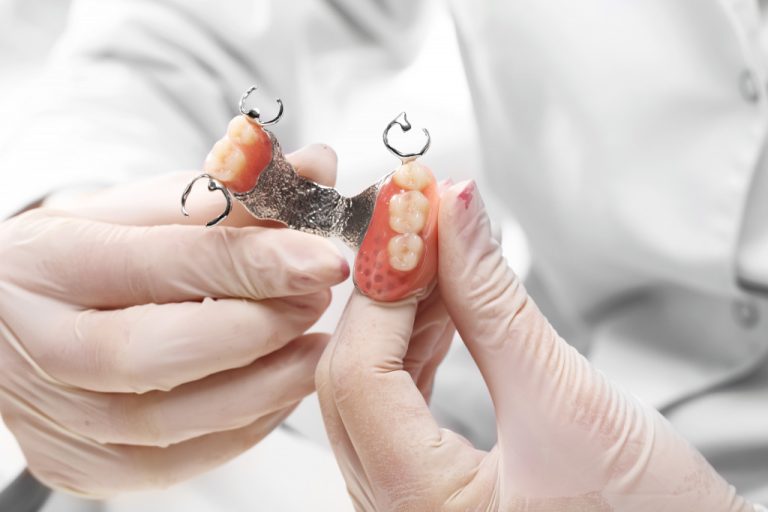Dentures have been a standard option for replacing missing teeth for many years. However, more options are now available to provide a better solution. From implants to bridges, there are numerous alternatives to dentures that may be more suitable in some instances. This article will explore the four best alternatives to dentures and discuss the advantages of each option.
Bridges
The first available treatment is a bridge, which acts as fake teeth by anchoring them onto existing ones. The false teeth are usually made of porcelain fused to metal and can either be removable or non-removable depending on the patient’s needs. Bridges often have an excellent cosmetic result but may not always be suitable for those with missing back teeth due to their lack of stability.
Fixed bridges are the most common type of bridge used, and they consist of two crowns that fit over the abutment teeth on either side and false teeth in between them, connected to a metal framework. A fixed bridge is strong, permanent, and can last up to 10 years with proper care. Cantilever bridges are also an option; they anchor the false tooth or teeth to one side of the abutment. They require less preparation for the adjacent abutment teeth but are not as strong as fixed bridges, so they may be more prone to breakage.
Resin-bonded bridges consist of false teeth that are connected to porcelain wings on either side, which are then bonded to the adjacent teeth. They can work well for front teeth and require minimal preparation but may be prone to staining or damage over time. Finally, implant bridges are an excellent option for those who have lost several teeth as they provide both form and function by using implants to support the bridge. However, they have the highest cost of all bridge options and require more time in the dental chair.
Overdentures
The second option is an overdenture, which attaches dentures to implants for more stability. Overdentures are an excellent choice for those with existing dentures that don’t fit well and may offer a more comfortable and secure fit than traditional dentures. They are also generally easier to maintain than implants, although they do require regular professional cleaning.
The advantage of overdentures is that they don’t require as many implants as traditional implant dentures. This makes them a more cost-effective solution and less invasive than other treatments. They also retain your jaw’s natural shape and structure, preserving facial aesthetics. Furthermore, overdentures are adjustable, which means you can modify them to suit your needs over time, allowing greater flexibility.
It is important to note that overdentures are temporary solutions that need to be replaced every few years. For the best results, it is recommended that you have them professionally examined regularly. Additionally, proper oral hygiene care is essential to maintain their quality and longevity.
All-on-Four Treatment
The third option for treatment is an all-on-four, which uses four dental implants placed in strategic locations within the jawbone. These implants can then be used to attach an entire arch of false teeth, creating a fixed bridge of prosthetic teeth that never need to be taken out. All-on-four treatments offer excellent stability and aesthetic results with minimal recovery time required after surgery.
In addition, all-on-four treatments are typically much less expensive than other restoration options for missing teeth. The treatment can also be completed in one appointment, making it a convenient option for people who would otherwise need multiple appointments over several months. Additionally, the implanted posts stimulate jawbone growth and prevent further bone loss in the area around the implants, helping to maintain the patient’s facial structure and encouraging healthy gums.
The all-on-four treatment also offers improved comfort over traditional dentures. Since the implants support false teeth, they are more secure and do not cause discomfort when eating or speaking. Furthermore, this restoration method allows patients to enjoy the same types of foods that they would typically eat with their natural teeth.
Partial Dentures
The final option is partial dentures, which are removable prosthetic devices used to replace one or more missing teeth. Partial dentures are usually made of acrylic and can be colored and shaped to blend with your existing teeth for a natural look. They also offer an affordable solution for those who need to replace multiple missing teeth, but it may not be suitable for those with missing back teeth due to their lack of stability.
Partial dentures can be an excellent option for those who want to replace missing teeth without undergoing major oral surgery. Additionally, partial dentures can help to preserve the jawbone structure by providing support and stimulation that would otherwise be lost with missing teeth. Furthermore, partial dentures can help to prevent other teeth from shifting out of alignment by filling the gaps created by missing teeth.
However, it is vital to consider the fact that partial dentures are not always suitable for those with missing back teeth due to their lack of stability in this area. If they become loose or ill-fitting, they can cause discomfort and further problems.
Final Words
In conclusion, there are numerous alternatives available when it comes to replacing missing teeth. Depending on the individual’s needs, any one of these options may provide a better solution than traditional dentures. It is essential to discuss all the options with your dentist to find the best fit for you.













